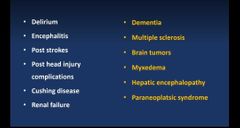![]()
![]()
![]()
Use LEFT and RIGHT arrow keys to navigate between flashcards;
Use UP and DOWN arrow keys to flip the card;
H to show hint;
A reads text to speech;
36 Cards in this Set
- Front
- Back
|
Psychosis definition |
is a severe mental disordercharacterized by disturbed reality testing andpoor judgment. |
|
|
Psychotic disorders symptoms |
Delusions Hallucinations Disorganized behavior Disorganized affect Disorganized speech or formal thought disorder thought control disorders |
|
|
Shizophrenia definition |
Schizophrenia is a mental disorder often characterizedby disturbed thinking, perception, affect, personality,and behavior and is usually associated with reducedsocial engagement and emotional expression, and lackof motivation. |
|
|
Age of onset and prevelance of shizophrenia |
prevalence is equal in males and females. The age of onset is usually around 20 earlier in males than females. |
|
|
What the Positive symptoms of shizophrenia? |
Are those that most individuals do not normallyexperience but are present in people with schizophrenia. They include delusions, hallucinations,disorganized speech, behavior and thought control disturbances. |
|
|
What the Negative symptoms of shizophrenia? |
Are deficits of normal emotional responses or of other thought processes. Negative symptoms appear to contribute more to poor quality of life, functional ability, and the burden on others than do positive symptoms. |
|
|
Other features of shizophrenia |
Other associated features include cognitive dysfunctions and affective disturbances andimpairment of functions
Commonly patients with schizophrenia presented with depressive or manic features. |
|
|
Common types of schizophrenic delusions are the following❓ |
⭐Persecutory delusions. ⭐Grandiosity delusions. ⭐ Delusions of reference: patient is convinced that people's talk is directed specifically towards him/her. |
|
|
Disorder of stream of thinking in shizophrenia 🤔 |
thought block (sudden stoppage of the train of thinking). |
|
|
Disorders of control of thinking in shizophrenia 🤔 |
⭐ Thought reading ⭐Thought insertion ⭐ Thought withdrawal ⭐Thought broadcasting |
|
|
Disorders of form of thinking🤔 |
These includeincoherence, loose association, incomprehensiblespeech, and illogical thinking. 🌟🤫Abstraction is usually impaired |
|
|
Disorders of Emotions in shizophrenia 🤔 |
⭐Flat and Blunt affect ⭐ Inappropriate or incongruent affect ⭐Marked transient changes in emotions |
|
|
Disorders of Perception🤔 |
⭐Hallucinations: sensory perception without a stimulus. ⭐Illusions: misinterpretation of real stimuli. May happen especially in acute cases |
|
|
Disorders of Behavior🤔 |
withdrawal, self-negligence,bizarre behavior, violence, excitement, suicidal acts, homocidal acts. |
|
|
Motor symptoms: (catatonic symptoms) of Shizophrenia |
⭐Posturing ⭐Negativusm ⭐Waxy flexibility ⭐Rigidity ⭐ Catatonic excitement ⭐ Catatonic Stupor |
|
|
Disorders of volition |
Lack of spontaneity, lack of drive, lack of ambition, hesitancy |
|
|
Enumerate positive symptoms |
Positive symptoms • Delusions • Hallucinations • Disorganized thinking and speech (formal thought disorder) • Incongruity of affect |
|
|
Enumerate Negative symptoms |
⭐Apathy ⭐Lack of drive and initiative, diminished volition ⭐Social withdrawal ⭐ Deterioration of social behavior ⭐Poverty of thought ⭐Blunting of affect |
|
|
Characters of paranoid (subtypes of Shizophrenia) |
• Later age of onset • Delusions (well systematized persecutory, jealousy) .• Auditory hallucinations • No marked deterioration of personality. |
|
|
Hebephrenic characters (subtype of Shizophrenia) |
• Earlier age of onset (adolescents and young adults) • Disorganized or Bizarre behavior • Incongruent affect • Formal thought disorder • Marked deterioration of personality and function |
|
|
Catatonic subtype of Shizophrenia characters |
Posturing, negativism, catatonic stupor or excitement, automatic obedience and waxy flexibility |
|
|
Simple subtype of Shizophrenia characters |
• Mainly disturbance of volition and emotion (flat affect). • Social withdrawal • Incongruent affect • No delusions or hallucinations |
|
|
Undifferentiated subtype of Shizophrenia characters |
Mixture of symptoms from different subtypes |
|
|
Subtypes of Shizophrenia |
⭐simple ⭐Residual ⭐Undeifferntiated ⭐catatonic ⭐ paranoid ⭐Hepephrenic |
|
|
Differential diagnoses of Patients presented with psychotic symptoms |

|
|
|
Substance and drugs Induced psychosis |

|
|
|
Other Psychotic disorders |

|
|
|
Management of shizophrenia |
place of therapy (hospitalization) medications (antipsychotics) Electroconvulsive therapy Psychosocial therapy:(Family therapy and educationRehabilitation of the patientOccupational and vocational therapy)
|
|
|
indications of ECT |
Catatonic schizophrenia Acute positive symptoms Acute excitement Homicidal thoughts or acts Suicidal thoughts or acts Refusal of food and medication |
|
|
Complications of ECT |
Impairment of short term memory for fewweeks Delayed recovery from anesthesia as anyminor surgical procedures |
|
|
acute psychosis is characterized by:- |
Rapid onset of symptoms
Patients look as if they are confused, Inattentive,perplexed, hesitant or fearful
Misidentification of people and places may happen
Symptoms may be changeable and not persistent Marked impairment of function Acute psychosis may be related or not to acutestress |
|
|
Treatment plan of acute psychosis |
-Hospitalization -ECT - low doses of antipsychotic -Psychotherapy: |
|
|
ECT is not indicated in treatment of acute psychosis except after |
Failure of other lines of treatment Confirming the diagnosis Pass of adequate time without improvement |
|
|
Schizoaffective disorder |
Full picture of depression or mania associated with schizophrenic picture |
|
|
Depression with psychotic features |
Mainly depressive symptomsIn addition to mood congruent delusions and hallucinations |
|
|
Do not argue with psychotic thinking (you maydisagree with the patient’s beliefs, but do not try toargue that they are wrong |
for you |

